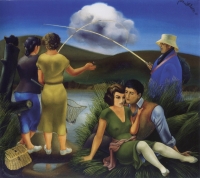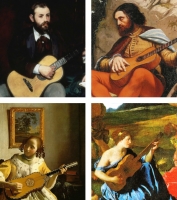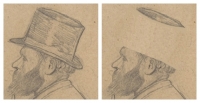29 Feb 2016
Re-writing Writers on Art
Years ago I thought that the Renaissance humanists who fought to have painting accepted as a liberal art knew a lot about the subject. It seemed a natural assumption but I was wrong. For us in search of art’s underlying meaning, it’s more im
18 May 2015
Still-lifes by Peale and Core [from the Archives]
Names are important in art. The American master Charles Willson Peale (1741-1827) had three sons who became painters: Rembrandt, Raphaelle [sic] and Titian. His fourth son was Rubens. Raphaelle is thought to be America’s first still-life painter
06 Mar 2015
C.S. Lewis on a Poetic Method
The late Sidney Geist, a sculptor and controversial interpreter of Cézanne's art, invited me about 12 years ago to come and see him at his studio in Manhattan. I had spent the past year studying everything about Edouard Manet and was excited to
24 Sep 2014 | 2 Comments
Reading Art: Manet, Picasso and Alfonso Ponce de Leon
My vision, like most people’s, is often cloudy which is why when the sun breaks and I gain some understanding, I get excited. You must excuse me. It may sometimes seem as if no-one before me has made similar observations. After all, all my ent
17 Apr 2014
Manet’s Spanish Singer Raises a Leg
Inspiration can come from anywhere so it's a good idea to look at the art of all periods. Artists do so, no matter which century they live in. A few days ago I solved one of my long-standing problems with a picture by the19th-century artist Edou
09 Feb 2014
Artists and the Thumb-hole of a Guitar
I read once that Cézanne prepared his palette with as many as 18 pigments and lined them up in a series like musical scales.1 It’s an apt analogy because painters have long portrayed musicians as an allegory of their own poetic performance in
13 Oct 2013
Higgs Boson and Mistakes
So, not long after the discovery of the Higgs boson and half a century after they predicted its existence, Higgs and Englert win the Nobel Prize in Physics. I don't often relate to advances in science but this one's a biggie. Last year, on news
28 Sep 2013
How Manet and other artists shoot their paintings
Have you ever shot your mother? Directors shoot movies and nearly everyone has made a snap-shot with a camera but few imagine that artists shoot paintings. In fact they have shot nearly every canvas with a gun in it since the devilish implements
09 Sep 2013 | 2 Comments
Art’s Unknown Frown
Artists frown. Constantly. Why? Charles Darwin considered the corrugator, the muscle which results in a frown, as the most remarkable of the human face because it irresistably conveys the idea of mind.1 And that's why, in my opinion, artists hav
26 Mar 2013
When Degas made a boob ...on purpose
In a new entry published today you can see for the first time ever how Edgar Degas turned his friend, Edouard Manet (above), into the driver of a carriage holding his whip as a paintbrush flecked with white paint. He then transformed the artist&
20 Mar 2013 | 2 Comments
How Degas drew a top hat…
Art is so pregnant that even in a "simple" sketch like Degas' Edouard Manet at the Races (c. 1865) there is always something more. I thought I had drained the drawing when I finished writing about it yesterday (see entry). And, then, this m
18 Feb 2013
1+1=1: The Divided Self in Manet’s Railway
What is the girl up to? Who are they? What's happening? Why do they wear the same color clothes? Why is the girl's hair so odd?
In my explanation two years ago of Edouard Manet’s The Railway (1873) I noted that the extended arm of the
11 Dec 2012
Memory Holloway and Picasso
Memory Holloway, an art historian at the University of Dartmouth, Massachusetts, has written a wonderful book on a magnificent group of etchings by Pablo Picasso. It is titled Making Time: Picasso's Suite 347. Suite 347 is the name given to
21 Sep 2012
Impressionism and Fashion
Impressionism and Fashion is the title of a new exhibition opening at Paris' Musée d’Orsay this coming Monday. The key image on the catalogue’s cover and the Museum’s website is Manet’s Young Lady of 1866
30 Aug 2012
Manet’s Modern Methods
I was crossing the road when a delivery truck owned by a prominent online grocery in the New York area stopped at a light. It displayed a poster of their managers holding a blow-up of the product each specializes in (right). One of the meat mana
30 Jul 2012
Have I Made Up Art’s Metaphors?
"Female stars have been rushing to publish photos of themselves without makeup" notes the New York Times. Rihanna, Lady Gaga, Jennifer Love Hewitt and others have started a trend whereby even women known for their makeup want their fans to see t
25 Jul 2012
Manet’s Little Cavaliers
Major artists are often inspired by earlier masterpieces yet when the young Edouard Manet entered the Louvre to copy whatever he wanted he chose an insignificant little painting. Yes, it was then attributed to Velazquez but Manet, with an in-dep
18 Jul 2012
Errors! Errors! Errors!
This is a piece of advice that I need to keep giving in case some newbies on the site have missed it. Even I sometimes forget it but Its importance cannot be overstated and is regularly overlooked in conventional art history. Look for the passag
12 Jul 2012
Ink Flies in a Mind
If anyone doubts that St. Sebastian holds a special place in the creative mind as a symbol of the artist’s self and the idea that every painter paints himself, then take a look at Jaff Seijas’ self-portrait above. It is not proof but it is t
03 May 2012
Art’s Tradition of Secrecy
Great poets are great poets because they have reached heights of spiritual understanding inaccessible to the crowd. The starting-point depends on the individual; some are born prophetic, others somewhere along the way. Those who begin at the bot
26 Apr 2012
Canvas is Canvas
Most of the visual metaphors for an artist’s implements revealed here are related to their referent in art through their form, their function or some other more abstract link. A rifle or sword is long and thin like a paintbrush. They must be a
21 Mar 2012
The Beauty of Concision
Just as brevity is the soul of wit, so concision in composition is beauty in art. A lyricist could have put that better but you get my point. Even if you don't, please take a look at how the little corner illustrated above, from Manet's
03 Mar 2012
How and Why Artists Steal
“It’s not always good to have ideas. Some people have a gift for coming up with ideas. But for those that don’t it is a real struggle. Oddly,” Paul Arden writes in his latest guide for creative wannabes, “the
19 Oct 2011
Find the link
What do you think links Manet's Absinthe Drinker to Picasso's Blue Period paintings?
Answer here.
31 Aug 2011
The Importance of Source-Hunting
Source-hunting, searching for the origin of a form in an earlier artist’s work, is one of the most maligned activities in art scholarship. John Shearman, a professor of the history of art at Harvard, wrote:
‘The study of sou
30 Jul 2011 | 1 Comments
Titian is a dog
Some viewers remain convinced that artists subconsciously fused their features into their portraits of other people - as Leonardo misleadingly suggested - even though the evidence is now strong that face fusion was practiced consciously and with
27 Apr 2011
Ratatouille and the Great Masters (of all genders)
What do Raphael’s La Fornarina and Ratatouille have in common? Much more than you might think, their superficial differences disguising their fundamental similarity. The idea that significant art depicts a moment of its own making within t
18 Mar 2011
Face Fusion is Everywhere
For years I’ve been rattling on about face fusion to demonstrate that portraits by true artists are not what they seem. Many are not accurate depictions but a fusion of features from different faces, often the artist’s own. Salvador Dali, fo
17 Jan 2011
Manet’s Errors
Edouard Manet would have been amused by his critics, then and now. In the 1950’s Clement Greenberg placed Manet at the center of his theory that modern painting had no meaning beyond emphasizing its own essential character. Thus the “flatnes
08 Jan 2011
Picasso and Paul McCartney’s Two Fingers
Alberti’s Window, an art history blog, has an intriguing video of Paul McCartney discussing the origin of his song Two Fingers. McCartney was in the waiting-room of a hospital staring at a poster of Picasso’s painting, The
The EPPH Blog features issues and commentary.





























